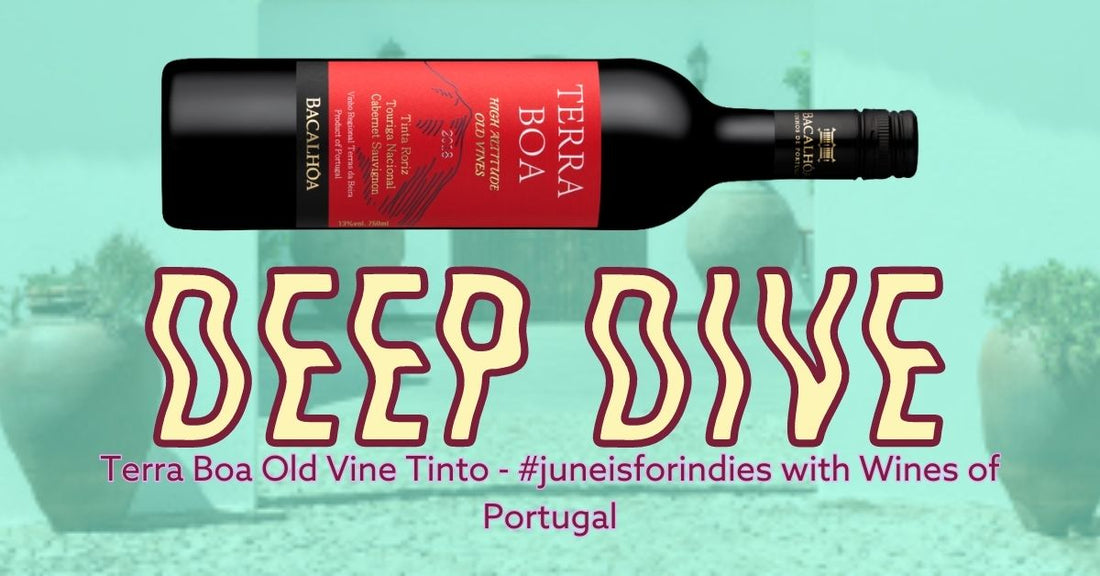Terra Boa Old Vine Tinto - Beiras, Portugal
Let's dive into the 1st of our 4 reds that we are highlighting for our #juneisforindies Wines of Portugal campaign.
Region:
Beira Interior wine region is located in the central part of Portugal. The region is divided into three subregions – the Castelo Rodrigo, Pinhel and Cova de Beira. Some of the highest mountains in Portugal create unique landscapes of the region. In recent times the Beira Interior has grown rapidly, and the number of wines produced has increased dramatically. The unique wine production methods and the high quality of the wines have made the Beira Interior one of the most well-respected wine regions of Portugal.
Terroir:
Terroir varies greatly in the Beiras region, which touches both sides of Portugal and takes in coastline, rivers, valleys, lakes, plateaux and low mountains. The same is true of the climate – although heavily influenced by the Atlantic in the maritime west, the continental draw of Spain's hot, dry center is strong in the east. In the west are the sandier soils of the coast, slightly inland are the limestone and clays of Bairrada, and the center has the alluvial soils of the Dão, Mondego and Ceira river valleys.
Grapes:
Baga is arguably the most important red wine grape in Beira. It typically makes up the lion's share of red wines, particularly in Bairrada, where it accounts for more than three-quarters of the red plantings. This wine is actually a blend of Tinto Roriz, Touriga Nacional and Cabernet Sauvignon. French grapes such as Merlot, Cabernet and Syrah are increasingly popular across Beiras, as they are the world over, and are often used to soften Baga wines and make them more immediately appealing to those wine consumers not yet seduced by classic Portuguese wine styles.
How it tastes:
Region:
Beira Interior wine region is located in the central part of Portugal. The region is divided into three subregions – the Castelo Rodrigo, Pinhel and Cova de Beira. Some of the highest mountains in Portugal create unique landscapes of the region. In recent times the Beira Interior has grown rapidly, and the number of wines produced has increased dramatically. The unique wine production methods and the high quality of the wines have made the Beira Interior one of the most well-respected wine regions of Portugal.
Terroir:
Terroir varies greatly in the Beiras region, which touches both sides of Portugal and takes in coastline, rivers, valleys, lakes, plateaux and low mountains. The same is true of the climate – although heavily influenced by the Atlantic in the maritime west, the continental draw of Spain's hot, dry center is strong in the east. In the west are the sandier soils of the coast, slightly inland are the limestone and clays of Bairrada, and the center has the alluvial soils of the Dão, Mondego and Ceira river valleys.
Grapes:
Baga is arguably the most important red wine grape in Beira. It typically makes up the lion's share of red wines, particularly in Bairrada, where it accounts for more than three-quarters of the red plantings. This wine is actually a blend of Tinto Roriz, Touriga Nacional and Cabernet Sauvignon. French grapes such as Merlot, Cabernet and Syrah are increasingly popular across Beiras, as they are the world over, and are often used to soften Baga wines and make them more immediately appealing to those wine consumers not yet seduced by classic Portuguese wine styles.
How it tastes:
Aromas of ripe bramble fruit, plum and a touch of spice. Generous on the palate with fresh red cherry and blackberry leaf characters - supple, fine tannins and a touch of spice on the juicy finish.
What to pair it with:
Chanfana
Chanfana is a traditional Portuguese stew. This stew is made with goat or lamb meat and baked in a traditional clay pot. To make the stew, the meat is placed in the pot and flavoured with piri piri, paprika, bay leaves and garlic. The seasoned meat is then covered with red wine and cooked for hours until the meat is soft and tender. This delicious stew is best enjoyed with boiled potatoes and a hearty red Beira wine.
One of the oldest cheeses in Portugal?
Queijo Serra da Estrela is a cheese that is native to the Serra da Estrela region. This cheese is semi soft and is made from sheep milk. The milk comes only from the Bordaleira Serra da Estrela and Churra Mondgegueira sheep breeds. These sheep are milked by hand. After this, the sheep milk is heated, and thistle extract is added to begin the curdling process. Once the curd is formed it is shaped into cheeses which are left to mature. Queijo Serra da Estrela is Portugal’s oldest food product. This cheese is so excellent that it has now gained international acclaim. Relax in the Beira Interior region and enjoy your Queijo Serra da Estrela as an appetizer or dessert with some excellent local wines.
What to pair it with:
Chanfana
Chanfana is a traditional Portuguese stew. This stew is made with goat or lamb meat and baked in a traditional clay pot. To make the stew, the meat is placed in the pot and flavoured with piri piri, paprika, bay leaves and garlic. The seasoned meat is then covered with red wine and cooked for hours until the meat is soft and tender. This delicious stew is best enjoyed with boiled potatoes and a hearty red Beira wine.
One of the oldest cheeses in Portugal?
Queijo Serra da Estrela is a cheese that is native to the Serra da Estrela region. This cheese is semi soft and is made from sheep milk. The milk comes only from the Bordaleira Serra da Estrela and Churra Mondgegueira sheep breeds. These sheep are milked by hand. After this, the sheep milk is heated, and thistle extract is added to begin the curdling process. Once the curd is formed it is shaped into cheeses which are left to mature. Queijo Serra da Estrela is Portugal’s oldest food product. This cheese is so excellent that it has now gained international acclaim. Relax in the Beira Interior region and enjoy your Queijo Serra da Estrela as an appetizer or dessert with some excellent local wines.
So give this versatile big bold BBQ red a whirl this summer - we guarantee you'll love it on its own. with friends, and with food!


